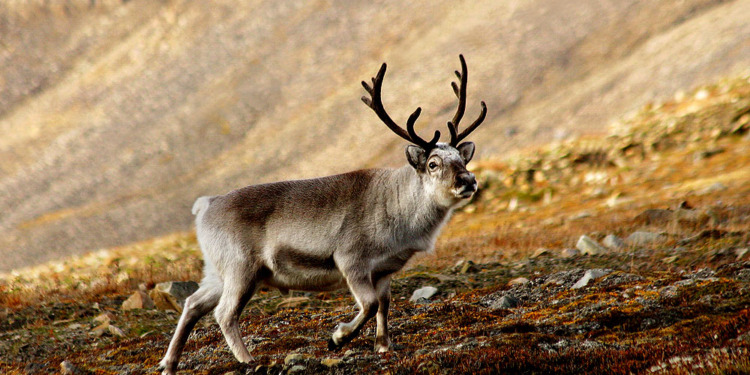Reindeer may have survived the last Ice Age, but a warmer Arctic is posing a formidable threat to these hardy animals. In the winter of 2013-14, 61 000 reindeer died of starvation in the Yamal peninsula of Russia. In Norway, 70% of undisturbed reindeer territory was lost to infrastructure developments by 1987. The disappearance of these animals is disastrous for indigenous reindeer herders like the Yamal Nenets in Russia, and the Saami who inhabit Sapmi, a region spanning northern Norway, Sweden, Finland, and west Russia. If their populations should be declining, though, Svalbard reindeer haven’t heard about it.
On Svalbard there has been a boom in reindeer populations, despite the fact that the archipelago is warming between five and seven times as fast as the global average, while the rest of the Arctic is warming four times as quickly. Peaking in 2018, the Ardventalen reindeer population nearly quadrupled since 1979.
This could be the result of Svalbard’s reindeer adapting to climate change by changing their diets. As a new study, published in Global Change Biology, now shows, the animals have been incorporating graminoids (grasses and grass-like plants) into their diets to survive the icier winters.
A warmer Arctic means wetter winters, with an increase in rain-on-snow events, which, since the 1990s, has become normalised. The rainfall often freezes, forming an ice sheet that traps the mosses the reindeer would eat in winter.
Though this occurred previously in the Arctic, climate change has massively increased the frequency of freeze and thaw events, with Yamal Nenet herders identifying historically bad icing events occurring about once a decade since the Second World War.
A warmer Arctic also means warmer springs and shorter winters. In Svalbard, the milder weather has led to greater plant biomass in spring, which means more abundant food sources for reindeer. Shorter winters mean the plants survive for longer periods, which translates into more food for the reindeer.
Furthermore, as grasses and shrubs cover more land, they stand vertically above the ice sheet, making them more available for consumption in the wet winters. The study found that between 1995 and 2012, mosses went from accounting for 30-50% of reindeer diets to a mean 26%, with graminoids making up the difference.
Related Articles: The Effects of Arctic Warming on Indigenous Communities | Could the Rate at Which Glaciers Are Melting Cause the Next Pandemic? | Rain to Replace Snow in the Arctic |Climate Change in the Arctic for Dummies — the Basic Facts We Need to Know to Care
On the one hand, being able to feed for longer periods in the spring and autumn allows reindeer to build higher fat reserves to survive the winters, when foraging becomes more energy intensive. Simultaneously, warm Octobers on Svalbard have been found to positively influence ovulation rates in female reindeer.
On the other hand, body mass in spring is negatively related to rain-on-snow events.
It is hard to know what this impact will have on the wider ecosystem of Svalbard. Increased mortality of reindeer in years of increased rain-on-snow may prove an important food source for Arctic foxes, which could, in turn, have cascading impacts on other herbivores in the food web, like geese and ptarmigan. One researcher cautioned that increased rain-on-snow events have been known to increase fungi and mould production under the snow in Sweden, leading reindeer to avoid certain areas.
It is worth noting that the population boom may not extend beyond Svalbard, and, indeed, isn’t true even for all of Svalbard. Research on Svalbard reindeer is often split into two distinct groups: reindeer in Adventalen, and reindeer in Brøggerhalvøya. The reindeer of Brøggerhalvøya, a peninsula on the north-western coast of Svalbard, tell quite a different story.
In Brøggerhalvøya, reindeer were extinct for a century before 15 were reintroduced in 1978. FifTheir population kept increasing until a rainy winter in 1993-94 that prompted a crash in reindeer numbers. Since then, the population has stayed stable at lower numbers.

In the rainy winter of 2018-19, 200 Svalbard reindeer starved to death. This was the most fatal season for the animals since 2007-08.
Reindeer all across Svalbard have been shown wandering unusually far to forage for food as regular food sources become inaccessible in icy winters. Some studies have noted reindeer across the archipelago, including Brøggerhalvøya, supplementing their diet with washed-up seaweed and kelp when the tundra is ice-locked. Unfortunately, this appears a less successful subsidiary than grasses.
Although there is no long-term study on the effects of kelp in reindeer diets, it has been observed to increase incidents of uncommon dental disease, malnutrition, and offspring mortality in sheep. Researchers noted unusually high rates of diarrhoea among stool samples of Svalbard reindeer that ate kelp.
While the success of reindeer consuming graminoids is encouraging in the face of a climate disaster, even on the island of Svalbard, success is not guaranteed. The animals are forced into ever more dire conditions, wandering far in search of vegetation that is locked under an icy surface. The farther-reaching consequences of the reindeer boom in the Svalbard eco-system are as yet unclear, and the seeming success of a population boom should be taken with a pinch of salt.
Editor’s Note: The opinions expressed here by the authors are their own, not those of Impakter.com — In the Featured Photo: A Svalbard Reindeer (Rangifer tarandus platyrhynchus). Featured Photo Credit: Per Harald Olsen










